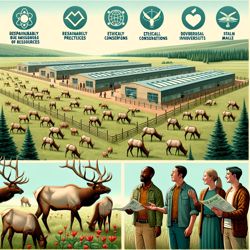Rainy River Elk Company Breeding Program
Rainy River Elk Company has played a pivotal role in Canada’s elk farming industry through its highly structured breeding program. Situated in Northwestern Ontario, the operation was originally founded to strengthen and improve the elk population for both commercial and conservation goals. Since the 1990s, the company has invested deeply in refining elk genetics and improving herd health to align with market demands and ecological sustainability.
Elk farming in Ontario began with government-supported relocation and preservation efforts. Rainy River Elk Company built on this foundation by introducing breeding methodologies from top-performing North American elk herds. Over the past two decades, it has developed a reputation for producing genetically superior and commercially viable elk. Today, its genetics are sought after by breeders across Canada and the northern United States.
Breeding Objectives and Genetic Selection Criteria
The company utilizes elite genetic selection protocols to achieve a rare combination of productivity, health, and adaptability in its elk. Its objectives focus on both the commercial antler market and healthy herd reproduction.
Core Breeding Objectives
- Antler Mass and Conformation: Targeting bulls with symmetrical, dense antlers that meet velvet and trophy demands.
- Reproductive Efficiency: Favoring cows with high calving percentages and early maturity markers.
- Disease Resistance: Selecting animals with no clinical signs or history of chronic wasting disease (CWD) or tuberculosis.
- Temperament and Adaptability: Breeding for low-stress animals that adapt well to intensive farming environments.
Genetic Evaluation Criteria
Rainy River uses estimated breeding values (EBVs) derived from five generations of data:
| Trait | Selection Goal | Data Source |
|---|---|---|
| Antler Weight at 4 years | >15 lbs per side | Annual weigh-in and imaging |
| Yearling Growth Rate | >0.85 kg/day | Monthly weigh records |
| Calving Interval | <365 days | Reproductive records |
| Gestation Traits | Synchronized breeding >85% | Hormonal treatment and record |
| CWD Susceptibility Markers | Negative for PRNP gene variants | Genetic testing laboratory |
All breeding decisions rely on a multi-trait selection index designed with consultation from livestock geneticists at the University of Guelph.
Elk Herd Management and Health Monitoring
Managing a breeding herd of over 500 head requires robust, consistent protocols. Rainy River Elk Company prioritizes animal welfare by integrating technology, herd segmentation, and veterinary oversight.
Herd Segmentation
- Cow Herds: Grouped by age and reproductive history.
- Breeding Bulls: Rotated annually among female groups to minimize inbreeding.
- Yearlings and Weanlings: Raised in isolation to monitor growth and train feeding behavior.
Daily Health Monitoring
- Visual inspections twice daily for signs of lameness, injury, or abnormal behavior.
- Bi-weekly nosal swab sampling in high-risk seasons (spring and autumn) for respiratory surveillance.
- RFID microchipping for all animals and real-time location tracking to detect behavioral anomalies.
- Monthly consulting visits by an on-call veterinarian with specialty in cervid health.
Emergencies trigger isolation and diagnostic testing under the company’s Biosecurity Hazard Protocol, which was updated following a 2016 respiratory outbreak mitigated through rapid containment.
Breeding Season Procedures and Techniques
Breeding success hinges on precise timing, hormonal treatment, and controlled exposure to selected bulls. The company adheres to evidence-based reproduction strategies to optimize pregnancy rates and genetic outcomes.
Synchronization
- Protocol: Controlled Internal Drug Release (CIDR) devices are used to regulate ovulation.
- Timing: Inserted for 12 days followed by prostaglandin injection 24 hours after removal.
- Response Rate: Over 87% of treated cows return to estrus within 48 hours.
Breeding Methods

- Natural Service: Primary breeding strategy with exposure to bulls selected 3 months prior.
- Artificial Insemination: Used with top five bulls chosen from semen analysis and genetic value.
- Embryo Transfer: Trials with donor cows have produced success rates nearing 68% in embryo viability.
Breeding occurs from mid-September to end of October to align with natural estrus cycles and optimize calving in late May to June.
Nutrition and Feeding Strategies for Breeding Success
Nutrition plays a crucial role in reproductive efficiency, antler development, and overall animal health. Rainy River Elk Company uses stage-specific feeding regimens based on NRC guidelines and proprietary feed mixes developed with ruminant nutritionists.
Breeding Cow Program
- Pre-breeding: High sugar, moderate protein (12%) feed to support ovulation.
- Breeding Season: Diet fortified with selenium, zinc, and vitamin E to improve embryo retention.
- Third Trimester: Higher caloric intake with added calcium and phosphorus to prepare for lactation.
Bull Nutrition Program
- Antler Outgrowth Phase (March–August): High-protein pelleted feed (16%), with added copper and manganese.
- Pre-Breeding (August–October): Increased fat energy sources to improve libido and stamina.
Feed Characteristics
| Feed Component | Purpose | Typical Inclusion Rate |
|---|---|---|
| Barley | Energy source | 50% of ration |
| Alfalfa Hay | Protein/fibre balance | 30% of forage ration |
| Canola Meal | Protein | 10% of concentrate |
| Vitamin Mix | Fertility + antler growth | Daily top-dress |
| Salt + Minerals | Trace elements | Provided free-choice |
Silage and pasture rotations are included during summer to simulate more natural foraging behaviors.
Calving Practices and Neonatal Care
Rainy River Elk Company achieves a calving rate of over 90% largely due to meticulous seasonal preparation and 24-hour monitoring during peak calving weeks.
Pre-Calving Preparation
- Cows moved to smaller calving paddocks two weeks before due dates.
- Bedding refreshed every 2 days and fly control maintained with mineral-based solutions.
- Colostrum management stations prepared with frozen colostrum and warming lamps.
Neonatal Interventions
- First 12 Hours: Vitamin A-D-E injection, navel dipping, RFID tagging.
- First 7 Days: Observation for passive immunity signs such as weight gain and feeding efficiency.
- Compromised Calves: Immediate supplemental bottle feeding and access to vet for sepsis rule-out.
The rotation of calving zones allows pastures to rest for up to a year between active seasons, enhancing calf survival by reducing pathogen exposure.
Record Keeping and Data Analysis in Breeding
Precision breeding cannot occur without detailed records on every individual animal. Rainy River Elk Company uses an advanced animal performance software integrated with RFID tagging and remote data capture systems.
Recorded Metrics
- Birth weight, timing, and sire/dam assignment
- Vaccination and veterinary interventions
- Growth benchmarks at 30, 60, 120, and 365 days
- Antler scoring and imaging annually starting at yearling age
- Reproductive cycle logs for cows including days open, heat scores, and calving assistance level
Records support annual herd improvement reports and inform culling decisions. This data is also shared with national cervid genetics databases like the Canadian Cervid Alliance for benchmarking.
Sustainable Practices and Ethical Considerations

Rainy River Elk Company balances productivity goals with environmental and ethical responsibility. Sustainable land and resource use form the foundation of its breeding operations.
Environmental Stewardship
- Rotational grazing and field rest enforce pasture regeneration
- Rainwater collection systems support livestock troughs and winter housing
- Neutral carbon footprint achieved through tree planting and solar barn heating systems
Animal Welfare Ethics
- Certified under the Canadian Code of Practice for the Care and Handling of Farmed Deer
- No use of growth hormones or routine antibiotics
- Strict culling standards for animals showing long-term distress or aggressive traits
Rainy River Elk Company continues to innovate breeding technologies while maintaining its commitment to conservation values. Through investing in genetics, health science, and land management, the facility helps push the Canadian elk industry toward long-term commercial and ecological viability.
